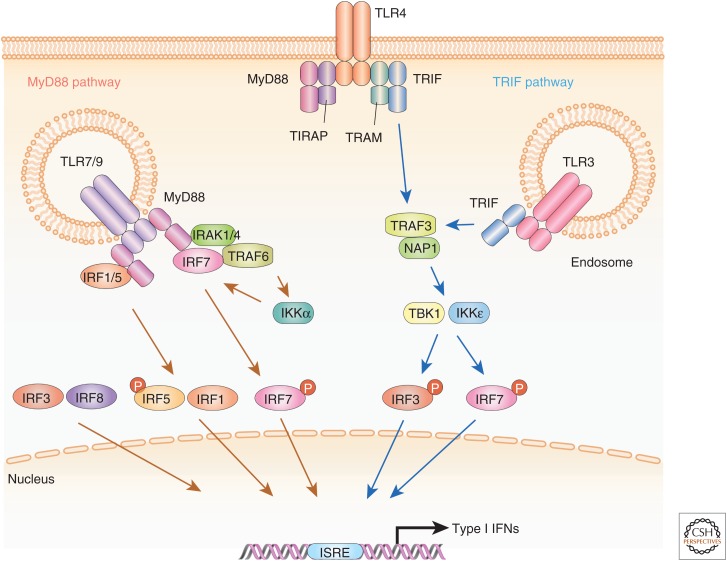Figure 2.
Schematic view of Toll-like receptor (TLR)-mediated type I interferon (IFN) gene induction by IFN regulatory factors (IRFs). The presence of RNA or double-stranded (ds)DNA in the cytosol triggers host responses via specific cytoplasmic pattern recognition receptors (PRRs). The binding of uncapped 5′-triphosphate RNA or dsRNA to the helicase domain of retinoic acid-inducible gene I (RIG-I)/melanoma differentiation-associated gene 5 (MDA5) induces the interaction between the caspase activation and recruitment domain (CARD) of RIG-I/MDA5 and the CARD-like domain of the adaptor mitochondrial antiviral signaling protein (MAVS), which is located on the mitochondrial membrane. This receptor–adaptor interaction results in the activation of tumor necrosis factor (TNF) receptor-associated factor (TRAF)-associated nuclear factor [NF]-κB activator (TANK)-binding kinase 1 (TBK1) and inhibitor of NF-κB kinase (IKK)ε. Activated TBK1 induces the phosphorylation of the specific serine residues of IRF3 and IRF7. These IRFs then translocate into the nucleus and activate the type I IFN genes. NF-κB is also activated and involved in type I IFN gene induction. In some cases, IRF5 or IRF8 participate in this IFN gene-induction pathway. dsDNA such as B-DNA is recognized by cGAS, IFI16, DDX41, and DAI. The stimulator of IFN genes (STING) adaptor protein on the endoplasmic reticulum membrane signals downstream of these DNA receptors. STING provides a scaffold for recruitment of TBK1, which phosphorylates IRF3 leading to the activation of type I IFN gene expression.

